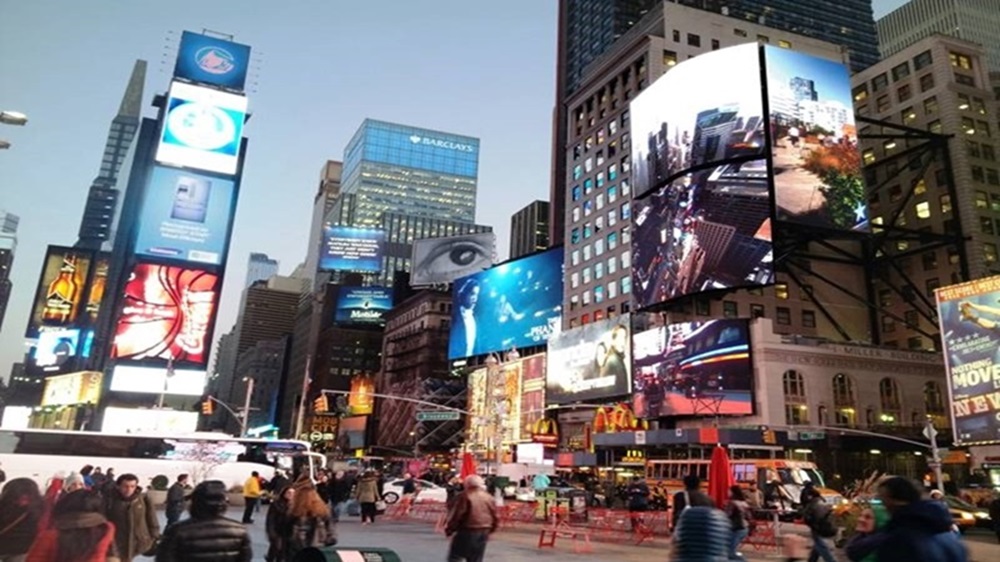LED technology dominates, selecting the right display is essential. This article provides practical insights into various LED display types and technologies, offering guidance for making the best choice based on your needs.
Types of LED Displays
Based on application scenarios and structural features, displays can be divided into indoor, outdoor, transparent, flexible, high-resolution, mobile, and rental screens. Let’s explore their characteristics and applications.
Features: Small pixel pitch, high grayscale, high refresh rate, wide color gamut.
Applications: Malls, retail stores, auto shows, training rooms, control rooms, command centers, and other indoor ultra-high-definition displays.
Features: High brightness, high protection, long viewing distance, energy efficiency.
Applications: Stations, airports, bus stops, outdoor billboards, stadiums, and other outdoor locations.
Transparent LED Display
Features: High transparency, lightweight, easy maintenance, energy-saving, supports ceiling mounting.
Applications: Stage performances, auto shows, television stations, festival events.
Flexible LED Display
Features: Curved flexibility, creative assembly, lightweight.
Applications: Commercial districts, shopping malls, auto shows, concerts, celebratory events, and other creative display scenes.
High-Resolution LED Display
Features: High contrast, wide color gamut, high grayscale, high refresh rate.
Applications: Conference rooms, command centers, cinemas, stadiums, monitoring centers, auto shows, press conferences.
Mobile LED Display
Features: Portability (easy to move), flexibility (adjustable position).
Applications: Mobile advertising vehicles, poster displays, weddings, mobile exhibitions.
Features: Various sizes, lightweight, quick installation, corner protection, easy maintenance.
Applications: Product launches, promotional events, weddings, auto shows.
Types of LED Display Technologies
Monochrome LED Display Technology: Uses a single color, like red, green, or blue, to display information by controlling brightness and switching.
Advantages: Low cost, low power consumption, high brightness.
Applications: Traffic signals, digital clocks, price displays.
Tri-Color Display Technology (RGB): Uses red, green, and blue LEDs to produce rich colors and images by adjusting LED brightness.
Micro LED Technology: An advanced display using tiny Micro LEDs, offering smaller size, higher brightness, and energy efficiency.
Applications: TVs, displays, VR devices.
OLED (Organic LED) Technology: Uses organic light-emitting diodes to create self-luminous displays when activated by current.
Applications: Smartphones, TVs, electronics.
Flexible LED Display Technology: Innovative technology using flexible materials, allowing the screen to adapt to curved surfaces for creative installations.
Transparent LED Display Technology: Offers transparency while displaying information, widely used in retail stores, exhibition halls, car showrooms for interactive displays.
Mini-LED and Quantum Dot LED Technology: Mini-LED provides higher brightness and contrast, while Quantum Dot offers a wider color gamut and vibrant color reproduction.
Creative LED Display Technology: Uses flexible LED modules to create various shapes, curves, and 3D effects for a unique viewing experience.
How to Choose the Right LED Screen
Application Scenario: Define the screen’s use case—indoor or outdoor, advertising, stage performance, or information display.
Resolution and Size: Select the appropriate resolution and screen size based on installation space and viewing distance.
Brightness and Contrast: Choose high brightness and contrast for outdoor or well-lit environments.
Viewing Angle: Select a screen with a wide viewing angle to ensure image consistency from different angles.
Color Performance: For applications where color quality is critical, choose a full-color display with excellent color reproduction.
Refresh Rate: Opt for a high refresh rate for fast-moving content to avoid image tearing and blurring.
Durability: Evaluate durability and reliability to minimize maintenance costs.
Energy Efficiency: Consider energy-efficient screens to reduce operational costs.
Budget: Balance the above factors within the project budget to select the most suitable LED screen.
Conclusion:
LED display screen offer high brightness, energy efficiency, high refresh rates, grayscale, and color gamut. When choosing a screen, consider the application, size, brightness, and other requirements. With evolving demands, future LED screens are expected to focus on higher resolutions, faster refresh rates, broader color gamuts, smart features, augmented reality (AR), and virtual reality (VR) innovations, leading the digital display technology forward.
Post time: Nov-11-2024

